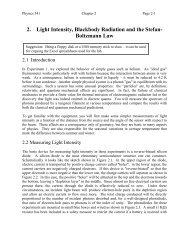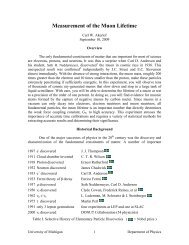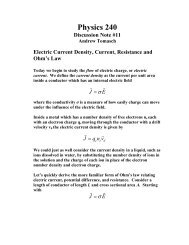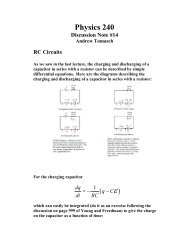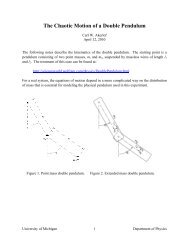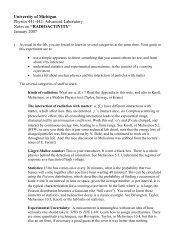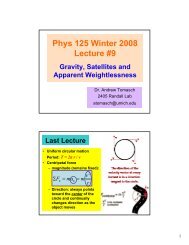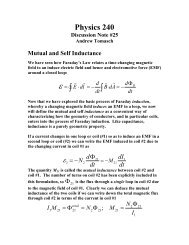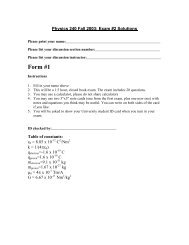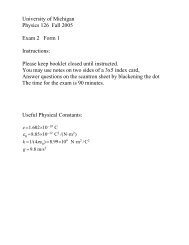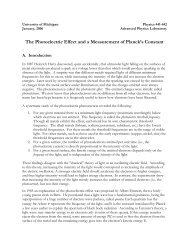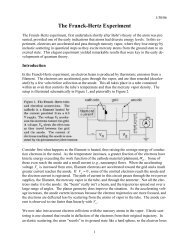Midterm 3 - University of Michigan
Midterm 3 - University of Michigan
Midterm 3 - University of Michigan
Create successful ePaper yourself
Turn your PDF publications into a flip-book with our unique Google optimized e-Paper software.
<strong>University</strong> <strong>of</strong> <strong>Michigan</strong>Physics 126 Winter 2010Name______________Section_______Exam 3 Form 1Instructions:Please keep booklet closed until instructed.You may use a new notecard on two sides <strong>of</strong> a 3x5 index card,plus your notecards from Exams 1 & 2.Answer questions on the scantron sheet by blackening the dotThe time for the exam is 90 minutes.Useful Physical Constants:eεkμ= 1.602×10−19C12 2 20= 8.85× 10−C /(N⋅m )= 1/(4 πε9 2 20) = 8.99× 10 N⋅m /C70= 4π× 10−T⋅m/A8c = 2.997×10 m/sh = 6.626×10-34J-s-15= 4.14×10 eV-sR = 1.097×107 m-1m-31e = 9.11×10 kgp-27m = 1.67×10 kgg = 9.8 m/s2−4T× 10-19J1 G = 101 eV = 1.6Discussion Sections# time leader3 8 am Merlin4 9 am Merlin5 10 am Merlin6 8 am Lau8 10 am Riles12 11 am Riles13 12 noon Riles14 1 pm Adams16 2 pm Adams17 3pm Adams1
1. When ultraviolet photons with a wavelength <strong>of</strong> 3.45 × 10 –7 m are directed at the surface<strong>of</strong> an unknown metal in vacuum, electrons with a maximum kinetic energy <strong>of</strong> 1.52 eVare emitted from the surface. What is the work function <strong>of</strong> the metal?A) 2.08 eVB) 3.60 eVC) 1.98 eVD) 2.59 eVE) 3.11 eV2. The headlights <strong>of</strong> a car are 1.6 m apart. The pupil <strong>of</strong> the eye <strong>of</strong> the observer has adiameter <strong>of</strong> 4.0 mm and a refractive index <strong>of</strong> 1.4. What is the maximum distance fromthe observer that the two headlights can be distinguished?A) 9.1 kmB) 13 kmC) 16 kmD) 11 kmE) 8.0 km3. In a cinema, a picture 2.5 cm wide on the film is projected to an image 3.0 m wide on ascreen which is 18 m away. The focal length <strong>of</strong> the lens is about:A) 7.5 cmB) 10 cmC) 12.5 cmD) 15 cmE) 20 cm4. Electromagnetic radiation with a wavelength <strong>of</strong> 5.7 × 10 –12 m is incident on stationaryelectrons. Radiation that has a wavelength <strong>of</strong> 6.577 × 10 –12 m is detected at a scatteringangle <strong>of</strong> :A) 10°B) 121°C) 40°D) 50°E) 69°5. A fish swims 2.00 m below the surface <strong>of</strong> a pond. At what apparent depth does the fishappear to swim if viewed from directly above? The index <strong>of</strong> refraction <strong>of</strong> water is 1.33.A) 2.66 mB) 3.00 mC) 1.50 mD) 2.00 mE) 1.33 m3
6. A laser emits a 5.0 × 10 3 -J pulse <strong>of</strong> light that has a wavelength <strong>of</strong> 480 nm. Determinethe number <strong>of</strong> photons in the pulse.A) 3.1 × 10 22B) 1.2 × 10 22C) 8.1 × 10 24D) 2.5 × 10 19E) 5.2 × 10 167. In a scene from a movie, a nearsighted character removes his eyeglasses and uses themto focus the nearly parallel rays <strong>of</strong> the sun to start a fire. What is physically wrong withthis scene?A) Sunlight cannot be used to start a fire.B) The eyeglasses have diverging lenses and cannot be used to focus parallel rays.C) Parallel rays cannot be focused.D) The eyeglasses have converging lenses and cannot be used to focus parallel rays.E) A fire can only be started if the image is virtual.8. Determine the wavelength <strong>of</strong> light emitted when electrons in a sample <strong>of</strong> hydrogenatoms make transitions from the n = 7 level to the n = 4 level.A) 3450 nmB) 2170 nmC) 950 nmD) 7300 nmE) 5910 nm9. In a Young's double-slit experiment, light <strong>of</strong> wavelength 500 nm illuminates two slitswhich are separated by 1 mm. The separation between adjacent bright fringes on ascreen 5 m from the slits is:A) 0.50 cmB) 1.0 cmC) 0.25 cmD) 0.10 cmE) none <strong>of</strong> the above4
10. Two rockets, A and B, travel toward each other with speeds 0.5c relative to an inertialobserver. Determine the speed <strong>of</strong> rocket A relative to rocket B.A) 0.6cB) cC) 0.8cD) 0.4cE) 0.2c11. A light ray is traveling in a diamond (n = 2.419). If the ray approaches the diamond-airinterface, what is the minimum angle <strong>of</strong> incidence that will result in all <strong>of</strong> the lightreflected back into the diamond? The index <strong>of</strong> refraction for air is 1.000.A) 65.58°B) 77.54°C) 32.46°D) 54.25°E) 24.42°12. In an experiment to determine the speed and position <strong>of</strong> an electron (m = 9.11 × 10 –31kg), three researchers claim to have measured the position <strong>of</strong> the electron to within ± 10 –9 m. They reported the following values for the speed <strong>of</strong> the electron:Researcher A 3 × 10 6 ± 2 × 10 4 m/sResearcher B 4 × 10 8 ± 2 × 10 7 m/sResearcher C 2 × 10 7 ± 5 × 10 5 m/sWhich <strong>of</strong> these measurements violates one or more basic laws <strong>of</strong> modern physics?A) A onlyB) B onlyC) A and BD) B and CE) A, B, and C5
13. A convex mirror has a radius <strong>of</strong> curvature <strong>of</strong> 0.50 m. Where must an object be placed infront <strong>of</strong> the mirror such that the image is formed 0.15 m behind the mirror?A) 0.57 mB) 0.093 mC) 0.19 mD) 0.375 mE) 0.77 m14. A man stands with his nose 8 cm from a concave shaving mirror <strong>of</strong> radius 32 cm. Thedistance from the mirror to the image <strong>of</strong> his nose is:A) 8 cmB) 12 cmC) 16 cmD) 24 cmE) 32 cm15. A 4.0 × 10 2 -nm thick film <strong>of</strong> kerosene (n = 1.2) is floating on water (n=1.33). Whitelight is normally incident on the film. What is the visible wavelength in air that has amaximum intensity after the light is reflected? Note: the visible wavelength range is380 nm to 750 nm.A) 420 nmB) 480 nmC) 530 nmD) 601 nmE) 380 nm16. In the year 2100, an astronaut wears an antique, but accurate, “quartz" wristwatch on ajourney at a speed <strong>of</strong> 2.0 × 10 8 m/s. According to mission control in Houston, the triplasts 14 hours. How long was the trip as measured on the watch?A) 8.9 hrB) 10.4 hrC) 18.8 hrD) 6.7 hrE) 16.1 hr17. A scuba diver shines a flashlight from beneath the surface <strong>of</strong> water (n = 1.33) such thatthe light strikes the water-air boundary with an angle <strong>of</strong> incidence <strong>of</strong> 37°. At what angleis the beam refracted?A) 65°B) 48°C) 90°D) 53°E) 31°6
18. A beam <strong>of</strong> electrons is incident on a single slit that has a width <strong>of</strong> 1.00 × 10 –6 m and adiffraction pattern is observed on a screen located 15.0 m from the slit. The momentum<strong>of</strong> an individual electron in the beam is 5.91 × 10 –24 kg ⋅ m/s. What is the width <strong>of</strong> thecentral maximum fringe?A) 7.50 × 10 –3 mB) 6.67 × 10 –4 mC) 5.87 × 10 –5 mD) 1.33 × 10 –4 mE) 3.37 × 10 –3 m19. How much energy would be released if 1.0 g <strong>of</strong> material were completely converted intoenergy?A) 9 × 10 9 JB) 9 × 10 16 JC) 9 × 10 8 JD) 9 × 10 11 JE) 9 × 10 13 J20. Without his contact lenses, Mr. Chong can focus from 0.80 m to infinity. Whatrefractive power <strong>of</strong> the lenses does he require for normal reading (0.25 m from theeyes)?A) 5.25 dioptersB) 1.25 dioptersC) –5.25 dioptersD) 4.00 dioptersE) 2.75 diopters7
Answer Key Exam 3 Form 11. A2. A3. D4. D5. C6. B7. B8. B9. C10. C11. E12. C13. D14. C15. B16. B17. D18. E19. E20. E8



